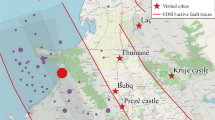Abstract
On December 26, 2004 a great earthquake (M W 9.3) occurred off the western coast of Sumatra triggering a series of tsunami waves that propagated across the Indian Ocean causing damage and life loss in 12 countries. This paper summarizes the observations of lifeline performance, building damage and its distribution, and the social and economic impact of the tsunami made by the Earthquake Engineering Field Investigation Team (EEFIT) in Thailand and Sri Lanka. EEFIT operates under the umbrella of the UK’s Institution of Structural Engineers. It is observed that good engineering practice can reduce economic losses, but additional measures are required to reduce risk to life.









Similar content being viewed by others
References
ADB (2005) Preliminary damage and needs assessment. 2005 Post-Tsunami Recovery Program, prepared by Asian Development Bank, Japan Bank for International Cooperation and World Bank, January 10–28, 2005
AIST (2005) December 26 tsunami in Indian Ocean. National Institute of Advanced Industrial Science and Technology, Japan. http://staff.aist.go.jp/kenji.satake/Sumatra-E.html
Ambraseys NN (1962) Data for the investigation of the seismic sea-waves in the Eastern Mediterranean. Bull Seismol Soc Am 52(4):895–913
Annunziato A, Best C (2005) The tsunami event analyses and models. Report of the Institute for the Protection and Security of the Citizen, Joint Research Centre, European Commission. January 2005
Bell R, Cowan H, Dalziell E, Evans E, O’Leary M, Rush B, Yule L (2005) Survey of impacts on the Andaman coast, southern Thailand following the great Sumatra-Andaman earthquake and tsunami of December 26, 2004. Bull New Zeal Soc Earthquake Eng 38(3):123–148
Blong R, Weir B, Milauskas B (2005) 26th December 2004 Indian Ocean earthquake and tsunami: the geophysical event. GAPResponse 3 – Indian Ocean earthquake and tsunami. Benfield ReMetrics Report, Benfield Group Ltd., 14 January 2005. http://www.benfieldgroup.com/Media+Centre/research+and+publications/#
BS6399-2 (1997) Loading for buildings: code of practice for wind loads. British Standards Insitute
Central Bank Annual Report (2005) Annual report of the Monetary Board to the Hon. Minister of Finance for the Year 2004. Central Bank of Sri Lanka, April 29, 2005
Dalrymple RA, Kriebel DL (2005) Lessons in engineering from the tsunami in Thailand. The Bridge, National Academy of Engineering, Washington, US 35(2):4–13
Department of Census and Statistics, Sri Lanka (2004) Reports on census of buildings and people affected by the tsunami. www.statistics.gov.lk
DPRI (2005) Comprehensive analysis of the damage and its impact on coastal zones by the 2004 Indian Ocean tsunami disaster. Kyoto University Disaster Prevention Research Institute, Japan. http://www.tsunami.civil.tohoku.ac.jp/sumatra2004/report.html
EEFIT (2006) The Indian Ocean tsunami of 26 December 2004: mission findings in Sri Lanka & Thailand. Pomonis A, Rossetto T, Peiris N, Wilkinson SM, Del Re D, Koo R, Gallocher S, Earthquake Engineering Field Investigation Team (EEFIT) Report, The Institution of Structural Engineers, London, UK. http://www.eefit.org.uk
IMF (2005) Preliminary assessment of the macroeconomic impact of the tsunami disaster on affected countries, and of associated financing needs, prepared by the IMF in Cooperation with the World Bank, February 4, 2005
Liu PLF, Lynett P, Fernando H, Jaffe BE, Fritz H, Higman B, Morton R, Goff J, Synolakis C (2005) Observations by the international tsunami survey team in Sri Lanka. Science 308(5728):1595
Lukkunaprasit P, Ruangsassamee A (2005) Observations on building performance in the Asian tsunami disaster and university roles. Presentation at the SOI Asia special symposium sharing knowledge across borders – tsunami: lessons learned and universities’ role. February 24, 2005, Bangkok, Thailand. http://www.soi.wide.ad.jp/soi-asia/conference/tsunami/
NASA (2005) Earthquake spawns tsunami. Natural Hazards, NASA Earth Observatory. http://earthobservatory.nasa.gov/NaturalHazards/natural_hazards_v2.php3?img_id=12640
Papadopoulos GA, Imamura F (2001) A proposal for a new tsunami intensity scale. ITS Proceedings Session 5(5-1):569–577
Peiris LMN (2006) Vulnerability functions for tsunami loss estimation. Proceedings of the First European conference on earthquake engineering and seismology, European Association for Earthquake Engineering and European Seismological Commision, September 3–8, 2006, Geneva, Switzerland. CD-Rom
Peiris N, Pomonis A, Wilkinson SM, Del Re D, Gallocher S (2006) Sri Lanka. In: The Indian Ocean tsunami of 26 December 2004: mission findings in Sri Lanka & Thailand. Earthquake Engineering Field Investigation Team (EEFIT) Report, The Institution of Structural Engineers, London, UK, pp 50–124. http://www.eefit.org.uk
Rossetto T, Pomonis A, Wilkinson SM, Koo R (2006) Thailand. In: The Indian Ocean tsunami of 26 December 2004: mission findings in Sri Lanka & Thailand. Earthquake Engineering Field Investigation Team (EEFIT) Report, The Institution of Structural Engineers, London, UK, pp 125–173. http://www.eefit.org.uk
Shuto N (1993) Tsunami intensity and disasters. In: Tinti S (ed), Tsunami in the world. Kluwer Academic Pubishers, Dordrecht, pp 197–216
Stein S, Okal EA (2005) Speed and size of the Sumatra earthquake. Nature 434(31):581–582
Tourism Authority of Thailand (2005) Statements and news releases from hotels, resorts and travel operators. Crisis Centre Update Centre, January 2005. http://www.tatnews.org/ccc/2412.asp and http://www.tatnews.org/others/2385.asp
Thai Ministry of Education (2005) Report on construction of school buildings in 4 provinces affected by tsunami. Web Report: http://www.moe.go.th/icpmoe/Other/Translated_News/Tsunami/school-buildings4-provinces.pdf
UNICEF (2005) Children in Tsunami Affected Countries. http://www.unicef.org/media/media_24628.html#facts
USGS (2004) Preliminary earthquake report 26 December 2004. U.S. Geological Survey, National Earthquake Information Center, World Data Center for Seismology, Denver. http://earthquake.usgs.gov/eqcenter/eqinthenews/2004/usslav/
Warnitchai P (2005) Lessons learned from the 26 December 2004 tsunami disaster in Thailand. Scientific forum on the tsunami: its impact and recovery. A regional symposium. Asian Institute Technology, Thailand, 6–7th June 2005
Wijetunge J (2006) Tsunami on 26 December 2004: spatial distribution of tsunami height and the extent of inundation in Sri Lanka. Sci Tsunami Hazard 24(3):225–239
World Bank (2006) World bank note on post-tsunami recovery and reconstruction, April 2006
Author information
Authors and Affiliations
Corresponding author
Rights and permissions
About this article
Cite this article
Rossetto, T., Peiris, N., Pomonis, A. et al. The Indian Ocean tsunami of December 26, 2004: observations in Sri Lanka and Thailand. Nat Hazards 42, 105–124 (2007). https://doi.org/10.1007/s11069-006-9064-3
Received:
Accepted:
Published:
Issue Date:
DOI: https://doi.org/10.1007/s11069-006-9064-3




